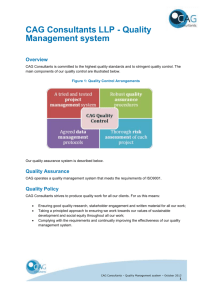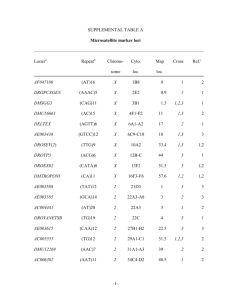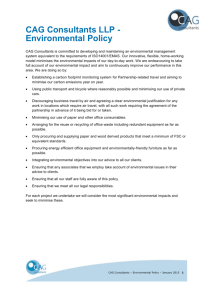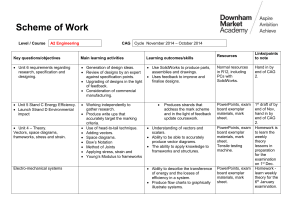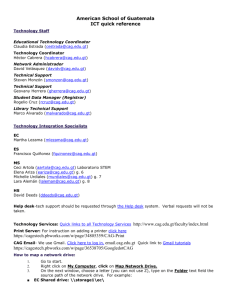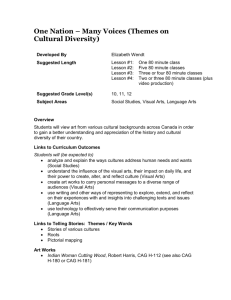Libby Community Advisory Group Meeting Summary December 14, 2006 Introductions
advertisement
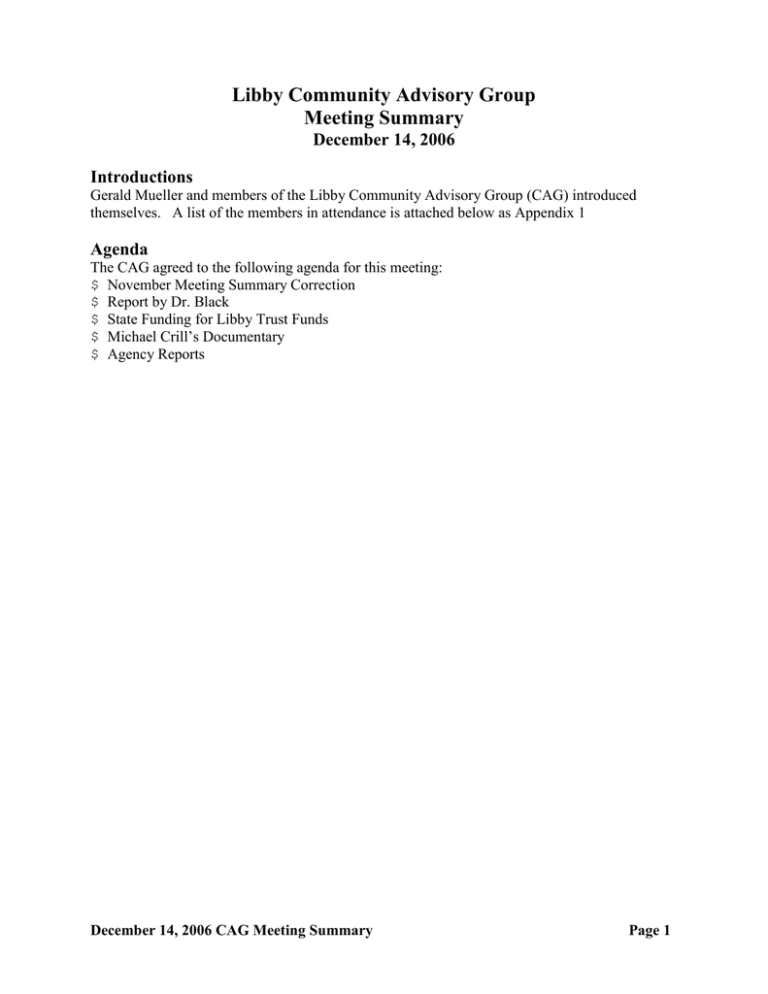
Libby Community Advisory Group Meeting Summary December 14, 2006 Introductions Gerald Mueller and members of the Libby Community Advisory Group (CAG) introduced themselves. A list of the members in attendance is attached below as Appendix 1 Agenda The CAG agreed to the following agenda for this meeting: $ November Meeting Summary Correction $ Report by Dr. Black $ State Funding for Libby Trust Funds $ Michael Crill’s Documentary $ Agency Reports December 14, 2006 CAG Meeting Summary Page 1 Review Draft - Not for Quotation S S S S EPA TAG CARD ARD Net December 14, 2006 CAG Meeting Summary Page 2 Review Draft - Not for Quotation $ Public Comment $ Next Meeting Agenda November Meeting Summary Correction Gerald Mueller reported that after the summary of the November 9, 2006 meeting was sent out, he received a request for a correction to it from Laura Wilson, who attended the meeting. Page 5 of the summary included the following audience member comment: December 14, 2006 CAG Meeting Summary Page 3 Review Draft - Not for Quotation “I raised this issue last month. I went back and checked and found that I had received a letter.” December 14, 2006 CAG Meeting Summary P a g e 4 Review Draft - Not for Quotation Ms. Wilson wrote that the report of this comment should also have included that the EPA letter that she received stated that all samples came back “non-detect” but now for some reason her property needs cleaning. December 14, 2006 CAG Meeting Summary Page 5 Report by Dr. Black Dr. Black reported on his presentation on research into a possible blood marker for mesothelioma at the International Symposium on Malignant Mesothelioma 2006 on October 20 21 in Chicago, Illinois. The Symposium was sponsored by the Mesothelioma Applied Research Foundation (MARF). This blood marker research is funded by a grant from MARF and is being conducted by CARD and Dr. Harvey Pass of the New York University Medical Center Department of Cardiothoracic Surgery. Dr. Black stated that there continues to be great interest in the research community about Libby. He is continuing to build relationships with other researchers that will help this community. Audience Member Question - Is there new information about stomach mesothelioma? Answer - Research is underway at Columbia University in New York on treatments for peritoneal mesothelioma. Water solutions of medication are being injected directly into the stomach. When cancer cells are metabolically active, they are more susceptible to medication. Audience Member Question - What is the success rate for this treatment? Answer - The treatment appears promising in terms of extending and improving the quality of life. More data are needed concerning it. CAG Member Question - Mesothelioma is terminal, is it not? Answer - Yes. December 14, 2006 CAG Meeting Summary Page 6 CAG Member Question - Are you familiar with the research of Dr. Bruce Case? Answer - He is working on environmentally induced mesothelioma, but more information is needed about the exposure that causes mesothelioma. CAG Member Question - Do you have literature from the symposium? Answer - I have abstracts. There were two meetings going on simultaneously, the international meeting and the MARF meeting. CAG Member Question - Are you familiar with the research by Dr. Robinson on vitamin Aretinal and the crocidolite exposure at Wittenoom, Australia? Answer - There are some results; however, there are concerns about lung cancer and the types of vitamin A. My feeling that this research is not yet presenting hope. Dr. Robinson originally developed the marker that we are using in our research. Crocidolite is in the same family as the Libby amphibole, and he and we share an interest in each other’s research. He may come here next summer. CAG Member Question - Didn’t this research show a 50% reduction in the incidence of mesothelioma? Answer - No such results were presented at the symposium. CAG Member Question - Is mesothelioma being reported from environmental exposures as well as occupational? Answer - Yes. Such results are reported for crocidolite exposure. Crocidolite was previously considered the most toxic form of asbestos. It is more toxic that chrysotile. CAG Member Question - Do we know the rate of mesothelioma from environmental exposures? Answer - No. CAG Member Question - The CARD’s Kimberly Rowse, RN, said something about a blood drawing at a recent ARD Net meeting. Is this part of the blood marker research? Answer - Yes. We are looking for a protein marker in the blood or urine. Dr. Pass is finding a higher incidence of this marker in Libby blood and urine samples. This research should help determine if the marker is related to the degree of exposure to asbestos and the extent of the disease. CAG Member Comment - Please keep us in the loop about the results of this research. State Funding for Libby Trust Funds Bill Patton passed out a copy of a proposed funding request to the upcoming legislature that he, K.W. Maki, and Eileen Carney developed at the CAG’s request. See Appendix 2. The request would funnel $3,000,000 to the Libby Asbestos Medical Plan (LAMP). Without additional funding LAMP is projected to run out of funds in less than a year at the current level of spending. This request was reviewed and approved by the LAMP Board of Directors. Assuming the CAG approves this proposal, the next step will be to take it to a member of the Libby state legislative delegation and seek their sponsorship of legislation to appropriate the $3,000,000 to LAMP. December 14, 2006 CAG Meeting Summary Page 7 Review Draft - Not for Quotation Audience Member Comment - The material in Attachment A describing LAMP lists on page 3 an eligibility requirement that is no longer is effect. The requirement is “A free, governmentsponsored screening program is not being conducted within a 200-mile radius from Libby, Montana.” Response by LeRoy Thom - You are correct. This is an old requirement no longer in force. CAG Member Question - Would the increased funding be used to cover more measures or to extend the program as it is? December 14, 2006 CAG Meeting Summary Page 8 Response by LeRoy Thom - Expenditure of the additional funding would be at the discretion of the LAMP Board. CAG Member Question - Does W.R. Grace dictate the level of health care provided by the LAMP fund? Answer by LeRoy Thom - The settlement of the litigation that provided the $2.75 million did allow W.R. Grace to have some discretion over the fund. However, we have a letter from a W.R. Grace attorney approving of the existing program. CAG Member Question - I have asked before and have not gotten a break down of LAMP expenditures by health care, prescription drugs, end stage care, home health care, etc. Could you please provide it? Answer by LeRoy Thom - Such a breakdown is difficult, but I will ask the Board to provide it. CAG Member Question - If the legislature provides additional funding, would it be subject to the existing W.R. Grace approved expenditure guidelines? Answer by LeRoy Thom - No, W.R. Grace would have nothing to say about the expenditure of funds provided by the legislature. We would set up a separate program within LAMP for expending the additional funds. Audience Member Question - Could funding for ARD Net come out of the requested legislative funds? Answer by Eileen Carney - Obtaining the funding from the legislature will be difficult. It is better to have the simple approach of funding only LAMP rather than more than one community program. Answer by LeRoy Thom - ARD Net is recognized as providing valuable services to the Libby community. I am confident that the LAMP Board would look favorably on a request for funding by ARD Net, should we receive the additional legislative funds. CAG Member Question - Why not ask for more than $3 million? Answer by Eileen Carney - The leadership of the Montana House of Representatives has stated that they wish to return the general fund surplus to Montanans rather than appropriate it to new purposes. The last request for funding for Libby also generated anger between Democrats and Republicans. We therefore decided to request only the $3 million. We will need everyone’s support to get this amount. CAG Member Comment - I read in the summary of its November meeting that the CAG decided to postpone further work on obtaining a declaration of a public health emergency under the federal Superfund law in favor of pursuing this state funding. We should not let up on seeking the declaration. CAG Action - The CAG agreed to the $3 million request to the legislature, and that the background paper should delete the 200-mile radius reference. Michael Crill’s Documentary CAG Member Comment - We should postpone this discussion until next month. CAG Member Comment - The video we reviewed was without scientific, artistic, or production merit. We should not discuss it further. December 14, 2006 CAG Meeting Summary Page 9 CAG Member Comment - I agree that it should not be discussed again. Comment by Mike Cirian - I need to correct to errors in the video. First, the video states that the dust from the Boothman barrow pit work is spreading asbestos contamination. This site was sampled from 0 to 6" in depth for asbestos and organic and non-organic contaminants. We also sampled every 3,000 cubic yards of material removed. No contaminants were detected. This pit was the source of clean top soil for the Libby cleanups. Second, the video alleges that the decontamination site on Rainy Creek Road used contaminated water that flowed to the Creek. This is also wrong. The decontamination water was filtered using a 5 micron filter. The used water was captured in a holding pond and not returned to the Creek. CAG Member Comment - I agree that we need not discuss the video itself again, but it does raise an important issue. The analytical technique used to sample the Boothman pit was polarized light microscopy (PLM). This technique has a detection limit of 0.2% by mass. A quarter teaspoon of material may have from 0 to 20 billion asbestos fibers and still have a concentration less than 0.2%. We should discuss this issue next month. CAG Member Question - Were any of the samples of the Boothman pit archived so that they could be re-examined? Answer by Mike Cirian - Yes, they were archived. CAG Action - The CAG agreed not to discuss the video further, and to put the PLM analytical issue on the next meeting agenda. TAG Report Gayla Benefield reported on behalf of the TAG. The TAG Technical Advisor, Dr. Gerry Henningsen, will be here next month. The TAG grant was renewed, and Dr. Henningsen’s contract was also. The TAG website is under development; comments regarding it are welcome. The TAG continues to meet on the Tuesday before the CAG meeting. Ms. Benefield also stated that Clinton Maynard deserves thanks for his persistence in his criticism of the Living with Vermiculite brochure which EPA finally withdrew recently. EPA Report Mike Cirian and Ted Linnert reported for EPA on the following topics. Living With Vermiculite Brochure - We stated erroneously at a previous meeting that the O&M Work Group helped to develop this brochure. This is not correct. The O&M Work Group did refer to this document in developing separate brochures for contractors, tradesmen, and homeowners. Cleanups - Construction is ended for this year. To date, a total of 794 properties have been cleaned, including 216 cleanups this year. Ambient Air Sampling - The sampling program is up and running, and one month of sampling has been collected. A report on the sampling program is available at the EPA Information December 14, 2006 CAG Meeting Summary Page 10 Center. The data for the month have not been evaluated, and it is too soon to report any results. We intend to release future ambient air sampling data on a quarterly basis. We are interested in comments on the data format. Environmental Response Specialist Position - We continue working through the O&M Work Group with representatives of the city, county, and state to develop this position. Its purpose is to assist people who run into vermiculite. Mike Cirian is piloting this position until the Record of Decision is finished so we can accumulate information about how often it is needed and its costs. So far, he has responded to three situations. A hole was punched in the outside wall of the Mint Bar, and vermiculite spilled. We covered the spill area with rock and will clean it next year. The county was recarpeting when it pulled up some telephone wires and a small amount of vermiculite was discovered. The vermiculite was vacuumed using a HEPA vacuum. Finally, a new property owner began a remodeling project. Remnants of vermiculite were discovered in the attic. Again, the vermiculite was vacuumed using a HEPA vacuum. The property has been added to the cleanup list, but the owner decided to continue the remodeling project. CAG Member Comment - I understand that EPA is running a wood stove program in Libby which includes ambient air monitoring. What is being monitored? Answer by Mike Cirian - This must be a different part of EPA. I haven’t heard what is being monitored. Audience Member Question - Press reports indicate that Senator Baucus is upset about the lack of toxicology information. Is anyone fired up about this topic in Denver? Answer by Ted Linnert - We were not surprised by the findings in the Inspector General’s report. We encourage everyone to read the report. It did not blast EPA. It made two recommendations, both of which we were already implementing. We have planned to reduce the number of cleanups next year to 160 so that we can fund the toxicology study. Also, as we explained two months ago, the Living with Vermiculite brochure was withdrawn. Audience Member Question - Wouldn’t it save money to clean properties right the first time? Answer by Mike Cirian - There is no documentation that we haven’t cleaned the properties correctly. Audience Member Comment - First EPA visited my property checking the ground for two hours. They then came back and spent a day and a half investigating my property. Response by Mike Cirian - I can explain these different visits. The first was the contaminant screening study. If something is found, the property is added to the cleanup list and the visit is ended. The second visit is the preliminary design investigation which is part of the cleanup design for your property. The actual cleanup will occur in a third visit. Audience Member Question - The person who just spoke has a situation like mine. After the first visit, we both received letters that no asbestos contamination was detected on our property. Why, then, were we both visited a second time? Answer by Mike Cirian - I apologize for the confusion. I will get your addresses after the meeting and look into your situations. CAG Member Comment - I have more concerns than just the Living with Vermiculite brochure. December 14, 2006 CAG Meeting Summary Page 11 I have contested the cleanup as not thorough or protective based on scientific literature and on the contamination that is being left behind. Jim Christiansen told me that the cleanups are protective. We have heard EPA respond to the criticism that the risk assessment is not done by arguing that not enough money was available to conduct both the cleanups and do the required science. However, Jim Christiansen told me that even if he had $50 million, he would not do anything differently. We have told EPA repeatedly that if they lack funding, this community will help get them the money they need. Money is not an excuse for the delay in getting the risk assessment done. The normal procedure at contaminated sites is to do the emergency cleanup, conduct a risk assessment, and then do the remedial cleanup. This has not been followed here. December 14, 2006 CAG Meeting Summary Page 12 Review Draft - Not for Quotation Asbestos Related Disease Network Karol Spas, Program Director for the Asbestos-Related Disease Network (ARD Net), explained the program using a handout. Five years ago, Eileen Carney obtained a grant from the Montana Department of Public Health and Human Services to pay for grant writing to find funds to assist people in the Libby community who have asbestos-related disease (ARD). This original funding was used to hire Commonweal Consulting who in turn wrote a Rural Health Outreach Grant. This request was successful and brought in $500,000 to fund case management and home assistance from June 1, 2003 through July 31, 2006. In 2005, Commonweal also drafted legislation sponsored by Ralph Heinert and Rick Maedje to provide ARD Net funding for this year. The bill passed. With this money, we are able to provide services in the following five areas: $ Case management services for people with ARD. $ Maintenance and oversight of a network of Lincoln county health care and social service providers. $ Direct services to people with ARD, including in home services, medical transportation, nutritional supplements, oxygen backpacks, and emergency phones. $ Annual surveys to evaluate the program’s effectiveness and quality. $ Pursuit of short- and long-term funding for health care and social services. December 14, 2006 CAG Meeting Summary Page 13 Review Draft - Not for Quotation CAG Member Question - My understanding was that the Rural Health Outreach Grant was for three years, and that you couldn’t apply for a second grant from this source for a year after the first grant expired. Are you now going to apply for another Rural Health Outreach Grant? Answer - This is possible, but the amount of funding for these grants has been reduced. December 14, 2006 CAG Meeting Summary Page 14 Review Draft - Not for Quotation Audience Member Question - What is your assessment of ARD Net’s funding needs and life span? December 14, 2006 CAG Meeting Summary Page 15 Answer - We are alright now, and we’re trying to look ahead. Audience Member Comment - ARD Net is trying to meet all the needs of people with ARD, but current funding limits its ability to do so. Audience Member Question - Is Commonweal continuing to search for grants to fund ARD Net? Answer - Yes. Searching for funding is part of their contract responsibility. Audience Member Comment - It is important to diversify your funding sources. Audience Member Question - How many people have been served by ARD Net? Answer - We provide home assistance for about 100, and case management for about 900. Audience Member Comment - ARD Net does a good job of providing service for the amount of money the program receives. Demographics indicate that the population exposed to asbestos is aging, so more services will be needed. The community needs to help ARD Net get funding. CARD Clinic Report The latest issue of the CARD newsletter is out and available to anyone wanting one. Public Comment There was no additional public comment. Next Meeting Agenda Topics The CAG agreed to the following topics for its next meeting: $ A discussion of the analytical technique used to sample the Boothman barrow pit. $ Continued discussion of the role and functioning of the CAG. Bill Patten passed out a handout discussing a follow-up on the CAG survey that he conducted and was discussed at the November CAG meeting. $ Agency reports. Topics for future CAG meetings include: $ A report by Wendy Thomi and Dr. Aubrey Miller about their experience with the World Trade Center cleanup. $ A report by UM researchers. Next Meeting The next meeting is scheduled for 7:00 to 9:00 p.m. on January 11, 2007 in the Ponderosa Room of Libby City Hall. Appendix 1 CAG Member & Guest Attendance List December 14, 2006 Members David L. Latham Group/Organization Represented The Montanian Newspaper December 14, 2006 CAG Meeting Summary Page 16 Bill Patten KW Maki Ted Linnert Mike Cirian Eileen Carney LeRoy Thom Gayla Benefield Clinton Maynard Dr. Brad Black St. John’s Lutheran Hospital Libby Schools EPA EPA - Libby MT State Board of Respiratory Care Therapists Former Grace Employee TAG - LCAVRO AARG CARD December 14, 2006 CAG Meeting Summary Page 17 Appendix 2 A Request for Funding from The Libby Community Advisory Group for The Libby Asbestos Medical Plan December 14, 2006 December 14, 2006 CAG Meeting Summary Page 18 Request The Libby Community Advisory Group (CAG) is requesting a one-time special allocation from the State of Montana in the amount of $3,000,000. These funds are requested for the Libby Asbestos Medical Plan (LAMP) and are needed to extend the life of this vital program. Background The LAMP became effective on September 1, 2003. The funds for the LAMP were provided by W.R. Grace & Company pursuant to an agreement with the U.S. Environmental Protection Agency in settlement of a lawsuit. The money was made available to the local community in order to pay for health care needs and screening services for those who had been exposed to asbestos. The LAMP program supplements the services that are paid for under the W.R. Grace Libby Medical Program that is administered by the Health Network of America (HNA)/Triveris. LAMP program applicants must meet specific residency requirements as well as asbestos exposure criteria related to the W.R. Grace Mine. Another eligibility requirement is that applicants must first be covered by HNA. A person with an asbestos related disease (diagnosis) must apply to and be approved for coverage by HNA for asbestos related claims. In the event HNA denies an applicants coverage request, the person is not eligible for Supplemental Benefits coverage through the LAMP. The LAMP program provides two specific types of benefits: • Screening benefits for people that have not been diagnosed with an asbestos related disease; and • Supplemental Benefits for healthcare services provided to people who have been diagnosed with an asbestos related disease. Attachment A is a copy of the plan document that details the LAMP program benefits and services. Other points to note regarding the LAMP program include: • W.R. Grace audits the claims that are processed by the LAMP every quarter. • Eligible diagnosis codes reimbursed as Supplemental Benefits are defined by HNA, the third party administrator for the W.R. Grace Company. • HNA/Triveris is not subject to any statutory requirements by the Department of Insurance respective to an audit of claims processing. The LAMP program was initially funded with $2,750,000. As of November 7, 2006 the plan had a balance of only $1,481,611. Attachment B is graph of the LAMPs quarterly expenditures. The graph shows a significant increase in expenditures over the last 5 quarters. While General and Administrative expenses have been stable, Health Care related costs have increased dramatically. The LAMP Board has determined that this trend is the result of HNAs increased rate of claim denials. At the current rate of spending, the fund will be exhausted in less than 1 year. As a result, the LAMP Board of Directors is considering benefit reductions in order to extend the life of the program. December 14, 2006 CAG Meeting Summary Page 19
